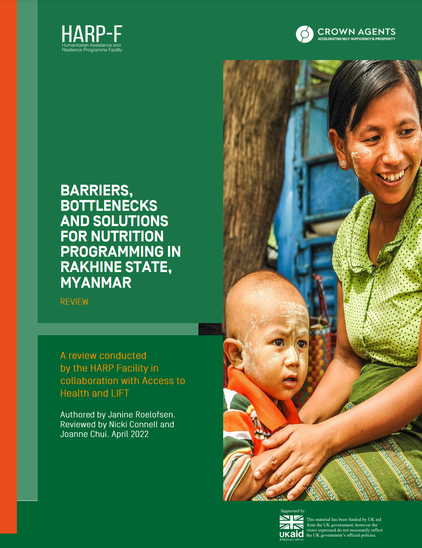Executive Summary
Introduction
Key nutrition services in Rakhine could not be implemented as planned in 2021. The nutrition dashboard for Rakhine (January to December 2021) showed that 41% of the target for severe acute malnutrition (SAM) treatment was reached (3,758 children out of 9,105 targeted), while for moderate acute malnutrition treatment (MAM) only 20% of the target was reached (6,425 children out of 31,509 targeted).
Many more (185,401) children 6-59 months of age were screened with mid-upper arm circumference (MUAC) in 2021 as compared to the Humanitarian Response Plan (HRP) target for the year of 87,327. The 4W overview (UNICEF August 2021) showed that MUAC screening was done in half of all villages and wards in Rakhine. The fact that many more children were screened and that substantially less were reached for MAM/SAM treatment (as compared to the annual targets) suggests that there is a discrepancy between screening and treatment.
Purpose
It is well-known that the context in 2020/2021 has been difficult and nutrition partners have faced many barriers, some of which were beyond their control. To increase coverage of nutrition services in Rakhine State, Myanmar, it is essential to understand and address the key barriers. This report aimed to identify key challenges and bottlenecks within the current situation and to develop realistic actionable solutions to overcome identified challenges for the treatment of wasting/ acute malnutrition as well as other nutrition services: infant and young child feeding (IYCF) services, blanket supplementary feeding programmes (BSFP), cash/food distributions and maternal and child cash transfer (MCCT) programmes).
Methods
A secondary literature review and key informant interviews (KII) with key stakeholders were conducted to identify barriers and solutions. A workshop with the Nutrition Cluster was conducted virtually to validate the key findings and prioritise barriers and solutions. Information was triangulated to formulate seven key barriers and recommended solutions.
Findings
The following are the priority barriers and solutions identified. There are five priority barriers related to nutrition treatment services and two priority barriers related to other nutrition services.



